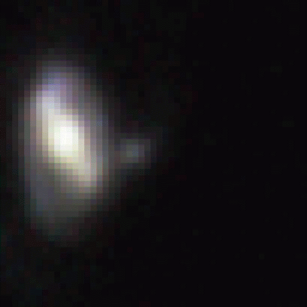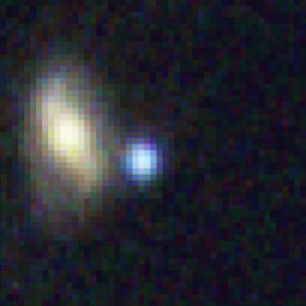
| SDSS Classic |
| SDSS.org |
| SDSS4.org |
| SDSS3.org |
| SDSS Data |
| DR19 |
| DR17 |
| DR10 |
| DR7 |
| Science |
| Press Releases |
| Education |
| Image Gallery |
| Legacy Survey |
| SEGUE |
| Supernova Survey |
| Collaboration |
| Publications |
| Contact Us |
| Search |

January 12, 2006
SDSS-II Supernova Survey explodes with new findings
WASHINGTON — The population of supernovae — exploding stars in distant galaxies — has exploded here on Earth with an unprecedented number of new discoveries logged in just 90 days by the Sloan Digital Sky Survey (SDSS-II).
The Sloan Supernova Survey today reported the discovery of 139 new Type Ia supernovae during its first campaign last fall.
These supernovae will be used to provide more precise constraints on the nature of the mysterious Dark Energy that is causing the expansion of the Universe to speed up. They will also yield greater understanding of supernovae as standard distance signposts (aka standard candles or standard light bulbs) in the Universe.
"Finding so many supernovae in such a short time is unprecedented, because the SDSS probes a larger volume of space than previous surveys," explained supernova team co-leader Joshua Frieman of the Fermi National Accelerator Laboratory (Fermilab) and the University of Chicago. The results were made public during a session on Supernovae and Cosmology at the American Astronomical Society's winter meeting in Washington, DC.
To find supernovae, the team used the dedicated SDSS-II 2.5-meter telescope at the Apache Point Observatory in New Mexico. Its 120-megapixel CCD camera is used to scan the same part of the sky roughly every other night over a three-month period, searching for supernovae that explode in any of the three million galaxies it sees. Comparing images taken on different nights, astronomers can look for objects that have brightened over time — potential supernovae. Shortly after it explodes, a supernova becomes as bright as an entire galaxy, so it can be seen across vast cosmic distances.
"An advantage of the SDSS is that it carries out nearly simultaneous imaging in five different portions of the optical spectrum, providing measurements of the colors as well as the brightness of objects," explained Masao Sako of Stanford University. Using these colors, Sako and other members of the SDSS-II supernova team were able to zero in with very high efficiency on the prized Type Ia supernovae, the most precise standard candles.
The most promising Type Ia candidates were targeted for follow-up spectroscopy on a variety of other telescopes, including the Astrophysical Research Consortium's 3.5-meter telescope, the Hobby-Eberly 9.2-meter telescope in Texas, the William Herschel 4.2-meter telescope in the Canary Islands, Japan's Subaru 8.2-meter telescope, Keck 10-meter telescope in Hawaii and the MDM Hiltner 2.4-meter telescope in Arizona.
"Follow up observations that measure the spectrum of the supernova are critical," explained team member John Marriner of Fermilab. "First, they confirm that the candidate is a Type Ia rather than some other kind of supernova, and second, they determine the velocity at which it is receding from the Earth." That recession velocity is caused by the expansion of the Universe; by combining the brightnesses and recession velocities of large numbers of supernovae, astronomers can unravel the history of the cosmic expansion rate.
Since supernovae are bright only for a few weeks, the candidates must be identified quickly so that their spectra can be measured before they fade. A cluster of 10 dual-processor computers at the observatory automatically processes the data and looks for differences between the images just taken and those of the same part of the sky in previous years.
"A full night of data collection with the telescope yields about 2,400 images, each one roughly equivalent to the image in a four-megapixel digital camera. We process these images with our computers in about 20 hours," explained supernova researcher Richard Kessler of the University of Chicago. "This accumulation of 70 gigabytes of images each night is equal to more than 100 CDs or 15 DVDs."
The new supernova sample also bridges the gap between the nearby supernovae found in local surveys and the very distant objects found by deeper surveys of much smaller areas. "The combination of a 2.5-meter aperture and a very large field of view makes the SDSS telescope ideal for finding intermediate distance supernovae, about 1 to 3 billion light years from Earth," explained Jon Holtzman of New Mexico State University. "Only a handful of supernovae at these distances had been found previously."
"All of the well-known results on the accelerating universe have so far come from comparing nearby supernovae to distant supernovae that were discovered and measured in different kinds of surveys," added Frieman. "The SDSS-II survey fills in the missing rungs on the ladder."
The race to improve the quality of supernova samples over a range of distances is heating up.
"The Sloan Supernova Legacy Survey and the ESSENCE survey are compiling more distant samples that will include hundreds of supernovae by the time they each finish a few years from now," noted Craig Hogan of the University of Washington. "Combining the SDSS results with these deeper surveys will probe the cosmic expansion and the nature of the dark energy with greater precision." (ESSENCE is a five-year supernova survey designed to constrain the physics of Dark Energy: ESSENCE website.)
The SDSS researchers are also looking forward to some surprises in the "astronomical zoo."
"We focused on the type Ia supernovae this season, because of the exciting cosmology applications, but the SDSS gives us a unique tool to study unusual supernova types," noted Stanford University's Roger Romani. "We have shown that we can sift through hundreds of new supernovae to select the rare gems. With a survey volume this large, these rarities turn up frequently enough to allow serious investigation of their place in the astronomical zoo."
Supernova background
Type Ia Supernovae are formed when white dwarf stars - the remnants of stars similar to our Sun -- collapse inward and blow up like an atomic bomb in brief but intense bursts of energy. The white dwarf accumulates gas from a companion star until it explodes, spewing gas and particles of iron, nickel and cobalt. The brightness of the Type Ia light peaks about three weeks after the explosion and declines over a period of months.
In the early 1990's, astronomers found that type Ia supernovae could be used to study cosmological distances because they appear to be accurate standard candles. In 1998, two research groups studying distant type Ia supernovae found that they were fainter than would be expected if the expansion of the Universe were slowing down due to the attractive pull of gravity. Instead, the evidence, which has since been confirmed by other cosmological observations, pointed to a speed-up of the Universe that began a few billion years ago. The cause of this acceleration is thought to be a bizarre form of energy, dubbed dark energy, which permeates the Universe and acts as a source of gravitational repulsion.
Information about the newly discovered SDSS-II supernovae has been distributed to the astronomical community via the International Astronomical Union circulars and the Central Bureau for Electronic Telegrams. These listings of supernova discovery dates, positions, magnitudes, and list of co-authors helps the community perform follow-up research. The public listing of confirmed supernovae is at the list of confirmed supernovae on this site.
The Sloan Supernova Survey is one of three research and discovery components of The Sloan Digital Sky Survey (II), which will run through mid-2008.
 |
 |
|
SDSS-II images of a Type Ia
supernova on the rise (left) and near maximum light (right). (CREDIT - SDSS-II Collaboration) | |
The population of supernovae - exploding stars in distant galaxies — has exploded here on Earth with an unprecedented number of new discoveries logged in just 90 days by the Sloan Digital Sky Survey (SDSS-II).
The SDSS-II Supernova Survey today reported the discovery of 139 new Type Ia supernovae during its first campaign last fall.
These supernovae will be used to provide more precise constraints on the nature of the mysterious Dark Energy that is causing the expansion of the Universe to speed up. They will also yield greater understanding of supernovae as standard distance signposts (aka standard candles or standard light bulbs) in the Universe.
Authors:
- J. Barentine, Apache Point Observatory
- B. Bassett, University of Portsmouth
- A. Becker, University of Washington
- R. Bender, University of Munich
- M. Bremer, University of Bristol
- H. Brewington, Apache Point Observatory
- F. DeJongh, Fermilab
- J. Dembicky, Apache Point Observatory
- D. L. DePoy, Ohio State University
- B. Dilday, University of Chicago
- M. Doi, University of Tokyo
- E. Elson, South African Astronomical Observatory
- J. Frieman, Fermilab and University of California
- P. Garnavich, University of Notre Dame
- M. Harvanek, Apache Point Observatory
- T. Gueth, New Mexico State University
- J. Holtzman, New Mexico State University
- U. Hopp, University of Munich
- W. Kollatschny, Goettingen University
- K. Konishi, University of Toyko
- J. Krzesinski, Apache Point Observatory
- H. Lampeitl, Space Telescope Science Institute
- R. Kessler, University of Chicago
- B. Ketzeback, Apache Point Observatory
- D. Long, Apache Point Observatory
- O. Malanushenko, Apache Point Observatory
- V. Malanushenko, Apache Point Observatory
- J. Marriner, Fermilab
- J. L. Marshall, Ohio State University
- R. McMillan, Apache Point Observatory
- G. Miknaitis, Fermilab
- T. Morokuma, University of Tokyo
- R. Nichol, University of Portsmouth
- K. Pan, Apache Point Observatory
- J.L. Prieto, Ohio State University
- M. Richmond, Rochester Institute of Technology
- A. Riess, Space Telescope Science Institute
- R. Romani, Stanford University
- M. Sako, Stanford University
- D. Schneider, Penn State University
- M. Smith, University of Portsmouth
- S. Snedden, Apache Point Observatory
- M. Subbarao, University of Chicago and Adler Planetarium
- N. Takanashi, University of Tokyo
- K. Tokita, University of Tokyo
- K. van der Heyden, South African Astronomical Observatory
- J. C. Wheeler, University of Texas
- N. Yasuda, University of Tokyo
Contacts:
- Joshua Frieman, Fermi National Accelerator Laboratory, University of Chicago, frieman@fnal.gov, 773-702-7971
- David Weinberg, Scientific Spokesperson, Sloan Digital Sky Survey, dhw@astronomy.ohio-state.edu, 614-292-6543
- Gary S. Ruderman, Public Information Officer, Sloan Digital Sky Survey, sdsspio@aol.com, 312-320-4794